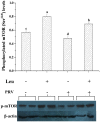Dietary Leucine Supplementation Improves the Mucin Production in the Jejunal Mucosa of the Weaned Pigs Challenged by Porcine Rotavirus
- PMID: 26336074
- PMCID: PMC4559446
- DOI: 10.1371/journal.pone.0137380
Dietary Leucine Supplementation Improves the Mucin Production in the Jejunal Mucosa of the Weaned Pigs Challenged by Porcine Rotavirus
Abstract
The present study was mainly conducted to determine whether dietary leucine supplementation could attenuate the decrease of the mucin production in the jejunal mucosa of weaned pigs infected by porcine rotavirus (PRV). A total of 24 crossbred barrows weaned at 21 d of age were assigned randomly to 1 of 2 diets supplemented with 1.00% L-leucine or 0.68% L-alanine (isonitrogenous control) for 17 d. On day 11, all pigs were orally infused PRV or the sterile essential medium. During the first 10 d of trial, dietary leucine supplementation could improve the feed efficiency (P = 0.09). The ADG and feed efficiency were impaired by PRV infusion (P<0.05). PRV infusion also increased mean cumulative score of diarrhea, serum rotavirus antibody concentration and crypt depth of the jejunal mucosa (P<0.05), and decreased villus height: crypt depth (P = 0.07), goblet cell numbers (P<0.05), mucin 1 and 2 concentrations (P<0.05) and phosphorylated mTOR level (P<0.05) of the jejunal mucosa in weaned pigs. Dietary leucine supplementation could attenuate the effects of PRV infusion on feed efficiency (P = 0.09) and mean cumulative score of diarrhea (P = 0.09), and improve the effects of PRV infusion on villus height: crypt depth (P = 0.06), goblet cell numbers (P<0.05), mucin 1 (P = 0.08) and 2 (P = 0.07) concentrations and phosphorylated mTOR level (P = 0.08) of the jejunal mucosa in weaned pigs. These results suggest that dietary 1% leucine supplementation alleviated the decrease of mucin production and goblet cell numbers in the jejunal mucosa of weaned pigs challenged by PRV possibly via activation of the mTOR signaling.
Conflict of interest statement
Figures

Similar articles
-
Dietary Lactobacillus rhamnosus GG Supplementation Improves the Mucosal Barrier Function in the Intestine of Weaned Piglets Challenged by Porcine Rotavirus.PLoS One. 2016 Jan 4;11(1):e0146312. doi: 10.1371/journal.pone.0146312. eCollection 2016. PLoS One. 2016. PMID: 26727003 Free PMC article.
-
Dietary Pectic Oligosaccharide Administration Improves Growth Performance and Immunity in Weaned Pigs Infected by Rotavirus.J Agric Food Chem. 2017 Apr 12;65(14):2923-2929. doi: 10.1021/acs.jafc.7b00039. Epub 2017 Mar 29. J Agric Food Chem. 2017. PMID: 28320203
-
Dietary vitamin D supplementation attenuates immune responses of pigs challenged with rotavirus potentially through the retinoic acid-inducible gene I signalling pathway.Br J Nutr. 2014 Aug 14;112(3):381-9. doi: 10.1017/S000711451400097X. Epub 2014 May 15. Br J Nutr. 2014. PMID: 24833277
-
Clays as dietary supplements for swine: A review.J Anim Sci Biotechnol. 2015 Aug 22;6(1):38. doi: 10.1186/s40104-015-0037-9. eCollection 2015. J Anim Sci Biotechnol. 2015. PMID: 26301092 Free PMC article. Review.
-
Regulation of mucin exocytosis from intestinal goblet cells.Biochem Soc Trans. 1995 Nov;23(4):810-3. doi: 10.1042/bst0230810. Biochem Soc Trans. 1995. PMID: 8654843 Review. No abstract available.
Cited by
-
Influence of Dietary Supplementation with an Amino Acid Mixture on Inflammatory Markers, Immune Status and Serum Proteome in LPS-Challenged Weaned Piglets.Animals (Basel). 2021 Apr 16;11(4):1143. doi: 10.3390/ani11041143. Animals (Basel). 2021. PMID: 33923708 Free PMC article.
-
Suhuai suckling piglet hindgut microbiome-metabolome responses to different dietary copper levels.Appl Microbiol Biotechnol. 2019 Jan;103(2):853-868. doi: 10.1007/s00253-018-9533-0. Epub 2018 Dec 7. Appl Microbiol Biotechnol. 2019. PMID: 30535578 Free PMC article.
-
Advances in the development of antivirals for rotavirus infection.Front Immunol. 2023 Mar 17;14:1041149. doi: 10.3389/fimmu.2023.1041149. eCollection 2023. Front Immunol. 2023. PMID: 37006293 Free PMC article. Review.
-
Lentinan administration alleviates diarrhea of rotavirus-infected weaned pigs via regulating intestinal immunity.J Anim Sci Biotechnol. 2021 Mar 9;12(1):43. doi: 10.1186/s40104-021-00562-6. J Anim Sci Biotechnol. 2021. PMID: 33750472 Free PMC article.
-
Effect of Dietary Lactose Supplementation on Growth Performance and Intestinal Epithelium Functions in Weaned Pigs Challenged by Rotavirus.Animals (Basel). 2022 Sep 8;12(18):2336. doi: 10.3390/ani12182336. Animals (Basel). 2022. PMID: 36139196 Free PMC article.
References
-
- Blikslager AT, Moeser AJ, Gookin JL, Jones SL, Odle J. Restoration of barrier function in injured intestinal mucosa. Physiol Rev. 2007;87: 545–564. - PubMed
-
- Farhadi A, Banan A, Fields J, Keshavarzian A. Intestinal barrier: an interface between health and disease. J Gastroen Hepatol. 2003;18: 479–497. - PubMed
-
- Langkamp-Henken B, Glezer JA, Kudsk KA. Immunologic structure and function of the gastrointestinal tract. Nutr Clin Pract. 1992;7: 100–108. - PubMed
-
- Magalhaes JG, Tattoli I, Girardin SE. The intestinal epithelial barrier: how to distinguish between the microbial flora and pathogens. Semin Immunol. 2007;19: 106–115. - PubMed
Publication types
MeSH terms
Substances
LinkOut - more resources
Full Text Sources
Other Literature Sources
Medical
Research Materials
Miscellaneous

